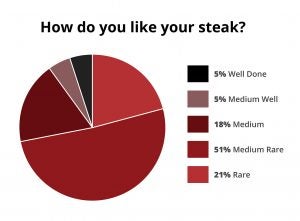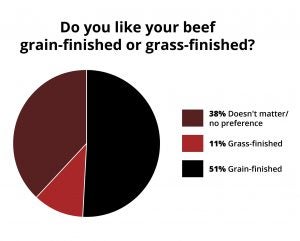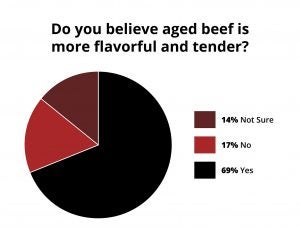When deciding to write about this topic, I quickly learned one thing: People are very passionate about their steaks! Ask an executive chef in any fine dining establishment, and they will most likely tell you that a steak should be properly seared, usually medium rare, you don’t need a lot of seasoning, and it should be aged. But just how much of this is true? And how does consumer perception stack up? Is grass-finished beef really preferred? I took a random social media poll on Facebook and Twitter to get some opinions and answers.
Another aspect of my social media experiment was to hear people’s opinions on how important it was to know their farmer, and is it worth it to pay more money for better cuts. A majority of people didn’t have too much of an opinion either way, but do believe it is worth it to pay more for better quality and flavor if it is within their budget. Knowing their farmer is important for some but not a huge deal for most. They’re more interested in how it’s cooked and most of the rare or medium rare lovers do believe it is a crime to overlook a high-quality piece of beef. Of the 350 folks included in the survey, here are some of the results:
The most popular result was grain-finished, aged, and medium rare.



Taste is relative and is a personal preference, of course, but I was a little surprised to see a majority of folks prefer grain-finished or “no preference” for beef, just based on the “grass-fed” marketing label. Pretty much all beef cattle are grass-fed until they are ready for finishing, then finished on grasses vs grains. I also prefer grain-finished for better marbling and flavor, but this is just my opinion.
The aging aspect can also impact the tenderness or taste of beef, although some butchers claim that beef should not be hung too long as it can grow a little harmless mold. Dry aged beef evaporates and is typically trimmed, thus increasing the cost. Beef can also be wet aged. After beef is cut, the ribeyes, sirloins, t-bones, strip steaks, and filets are packaged in plastic bags and vacuum sealed and stored in refrigerated temperatures for four to six weeks. The term “wet aged” means it was aged in its own juices, unlike dry aging which means it ages in a special cooler or cabinet, not in specific packaging. Wet aging has a more rare, acidic flavor while dry aging has a more brown-roasted well-done flavor. Both would be tender and juicy, it just depends on personal preference. For more info, check out Janeal Yancey’s blog who has a PhD in meat science — www.momatthemeatcounter.blogspot.com.
From the farmer’s perspective, there were mixed opinions on whether or not cooking a steak well done would be an insult to our craft. Some farmers believed no one should ever cook a steak beyond medium rare as it does a disservice to the product, however, others claimed they didn’t have an opinion either way. If they want to buy it, who cares what they like? To each their own. How to cook the steak itself, particularly if it is a high-quality cut, seems to be more offensive to the chef than it does to the farmer. One key take away: A majority of rare and medium rare lovers find it appalling to cook a high-end beef cut to well done, with comments flowing into, “It’s not jerky! It’s not shoe leather!” But just like with wine, our personal palates may vary.
Michelle Miller, the Farm Babe, is an Iowa-based farmer, public speaker and writer, who lives and works with her boyfriend on their farm which consists of row crops, beef cattle, and sheep. She believes education is key in bridging the gap between farmers and consumers.



